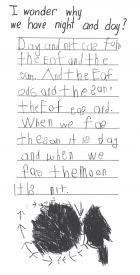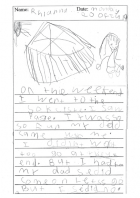You are here:
After one year at school

Reading
Reading
In their first year at school, students are engaging with texts as they learn in a range of contexts across the curriculum. Many texts, including picture books and topic-related non-fiction books, are read aloud by the teacher. The texts that students read largely by themselves are usually selected specifically to meet instructional reading purposes.
After one year at school, students are reading, responding to, and thinking critically about a variety of fiction and non-fiction texts at Green level. They use a range of sources of information in the text, along with their prior knowledge, to make sense of the texts they read. They know that reading should be phrased, and they read at an appropriate pace. With some teacher guidance, students use strategies such as asking questions and making inferences to help them think more deeply about the ideas in the text.
When students at this level read, respond to, and think critically about texts, they:
- understand that we read to get meaning
- confidently approach challenges in their reading and persevere when they are having difficulties, because they know how to problem-solve
- monitor their own reading and self-correct where necessary, using strategies such as rerunning text or checking further sources of information
- use a variety of comprehension strategies to interpret and respond to a range of texts.
They draw on knowledge and skills that include:
- having all concepts about print under control
- using appropriate language about books, (for example, the terms title, author, and illustration)
- using their developing phonemic awareness to aurally identify and distinguish individual phonemes within words, for example, to blend phonemes (for example, by saying m/a/n/ is man) and to segment phonemes (for example, by saying seat is s/ea/t/)
- identifying all letters by name and being able to produce an associated sound for each letter
- automatically recognising many (100–200) of the high-frequency words in their instructional texts
- decoding unfamiliar words by using their developing knowledge of grapheme–phoneme relationships, which enables them to:
- identify common graphemes (for example, sh, ch, ow, ai, th, oy) and produce an associated sound for each one
- apply the knowledge that letters can be pronounced in different ways (for example, about, and, apron)
- apply strategies such as: sounding out words; using knowledge of graphemes (for example, sh, aw, t, p, or); and using analogy to read words that contain familiar chunks (for example, est, en, ump)
- decoding unfamiliar words by using some knowledge of morphology (for example, the word endings -s, -ing, and -ed)
- applying their knowledge of vocabulary in order to understand words as they decode them and to make meaning at the sentence and whole-text level
- understanding the meaning of basic punctuation features (for example, full stops, speech marks, and exclamation marks).
Reading Standards Illustrations: Illustrations of text relating to specific curriculum tasks and its reading demands can be viewed here. These illustrations are examples that show how a student is meeting the reading standards through a curriculum task.
Writing
Writing
In their first year at school, students create texts in a range of contexts across the curriculum. The texts that students write largely by themselves usually meet specific instructional writing purposes. They write about their experiences and ideas as well as writing to record information on different topics.
Once students start making links between their phonological and phonemic awareness and what they can read or write, their growing knowledge of the code of written language in turn enhances their awareness of the sounds and complex rules of spoken English.
page 71
After one year at school, students begin to use specific processes to create texts, and these processes may vary depending on the particular purpose for writing. The students are able to read and talk about their completed texts.
When students at this level create texts, they:
- plan for writing, using talk, text, or drawing
- convey simple ideas, responses, opinions, or questions
- reread what they have written, as they write, to maintain meaning
- respond to feedback by making changes such as adding or deleting details or changing punctuation or spelling.
They draw on knowledge and skills that include:
- using vocabulary drawn from their own oral language or encountered in their reading or other classroom activities
- using their developing phonemic awareness to aurally segment words into syllables (e.g., win-dow, ham-bur-ger) and one-syllable words into individual phonemes (for example, b/a/n/d; sh/i/p)
- using their developing visual memory to accurately write some key personal words and some high-frequency words1
- encoding (spelling) unfamiliar words by using their developing knowledge of phoneme– grapheme relationships, which enables them to:
- recognise and write most sounds of English in at least one appropriate way (for example, s, t, ch, ow, k, f, oy)
- recognise that there can be different ways of representing the same sound (for example, phone/father; keep/cat)
- apply sound–letter relationships in order to write words they want to use (for example, catapulla)
- encoding (spelling) unfamiliar words by using their developing knowledge of morphology to write word endings correctly (for example, jump/jumped; boy/boys)
- using classroom resources such as wallcharts and picture dictionaries
- forming all upper-case and lower-case letters and numerals correctly
- understanding simple text types (for example, personal recounts and simple descriptions) and using them to meet their writing purpose
- composing simple sentences and composing some compound sentences using conjunctions such as and or but;
- using capital letters and full stops to begin and end sentences.
Writing Standards Illustrations: Illustrations of students' texts provide a snapshot of the skills and strategies the students have used to meet the writing demands of the curriculum can be viewed here. These illustrations are examples that show how the student is meeting the writing standards through a curriculum task.
1. Examples of high-frequency words appropriate at this level could include most words from Essential List 1 and some words from Essential List 2 in Croft (1998).





